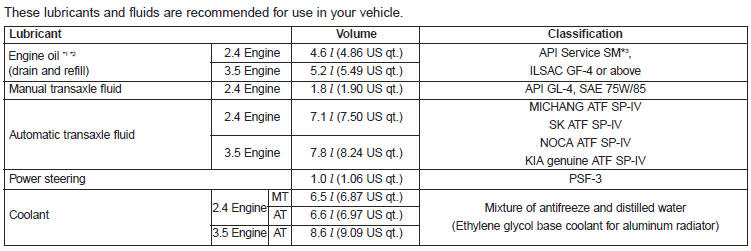Recommended lubricants and capacities
To help achieve proper engine and powertrain performance and durability, use only lubricants of the proper quality. The correct lubricants also help promote engine efficiency that results in improved fuel economy.


*1 Refer to the recommended SAE viscosity numbers on the next page.
*2 Engine oils labeled Energy Conserving Oil are now available. Along with other additional benefits, they contribute to fuel economy by reducing the amount of fuel necessary to overcome engine friction. Often, these improvements are difficult to measure in everyday driving, but in a year’s time, they can offer significant cost and energy savings.
*3 If the API service SM engine oil is not available in your country, you are able to use API service SL.
*4 Diesel Particulate Filter
MT : Manual transaxle
AT : Automatic transaxle
Recommended SAE viscosity number
CAUTION viscosity from the chart.
Always be sure to clean the area around any filler plug, drain plug, or dipstick before checking or draining any lubricant. This is especially important in dusty or sandy areas and when the vehicle is used on unpaved roads. Cleaning the plug and dipstick areas will prevent dirt and grit from entering the engine and other mechanisms that could be damaged.
Engine oil viscosity (thickness) has an effect on fuel economy and cold weather operating (engine start and engine oil flowability). Lower viscosity engine oils can provide better fuel economy and cold weather performance, however, higher viscosity engine oils are required for satisfactory lubrication in hot weather. Using oils of any viscosity other than those recommended could result in engine damage.
When choosing an oil, consider the range of temperature your vehicle will be operated in before the next oil change.
Proceed to select the recommended oil viscosity from the chart.

1. For better fuel economy, it is recommended to use the engine oil of a
viscosity grade SAE 5W-
20 (API SM / ILSAC GF-4). However, if the engine oil is not available in your
country, select
the proper engine oil using the engine oil viscosity chart.
See also:
Theft-alarm system
This system is designed to provide protection
from unauthorized entry into the
car. This system is operated in three
stages: the first is the "Armed" stage, the
second is the "The ...
If you have a flat tire
Jack and tools
The jack, jack handle, and wheel lug
nut wrench are stored in the luggage
compartment. Pull up the luggage
box cover to reach this equipment.
(1) Jack handle
(2) Jack
(3) Wheel ...
Best-in-Class Performance
The 2011 Sorento offers two engines, both more powerful than the Ford Escape
and Honda CR-V. A 3.5-liter V6 providing best-in-class 276 horsepower and 248
pound-feet of torque and a 2.4-liter four ...


